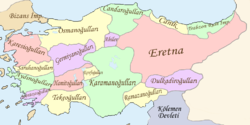Eretnids
| The Eretnid Dynasty | ||||||||||||||||
| Beylik | ||||||||||||||||
|
||||||||||||||||
|
The Eretnids under Eretna
|
||||||||||||||||
| Capital | Sivas and Kayseri | |||||||||||||||
| Languages |
Arabic Mongolian Persian Turkish |
|||||||||||||||
| Religion | Islam | |||||||||||||||
| Government | Monarchy | |||||||||||||||
| Sultan | ||||||||||||||||
| • | 1336–1352 | Eretna b. Jafar, Ala al-Din | ||||||||||||||
| • | 1380 | Muhammad II Chelebi | ||||||||||||||
| History | ||||||||||||||||
| • | Established | 1335 | ||||||||||||||
| • | Disestablished | 1381 | ||||||||||||||
|
||||||||||||||||
Eretnids (Turkish plural; Eretnaoğulları) was an Anatolian beylik that succeeded the Ilkhanid governors in Anatolia and that ruled in a large region extending between Caesarea (Kayseri), Sebastea (Sivas) and Amaseia (Amasya) in Central Anatolia between 1328–1381. The dynasty was founded by Eretna, an officer of Uyghur origin in the service of Ilkhanid governors of Anatolia. Although short-lived, the Beylik of Eretna left important works of architecture. The name of Eretna may be derived from Sanskrit word Ratna "Jewel" or Tuvan (Turkic) language word "Ertine" (эртине) "treasure,jewel, value, esteem, appreciate, dignify, treasure, cherish ".
The dynasty's founder, Eretna, was a Mongol officer of Uyghur origin in the service of Timurtash, the Ilkhanid governor of Anatolia. After his master unsuccessfully revolted in 1327 to ally with the Mamluks in response to the fate of his father Chupan, Ilkhan Abu Said appointed Eretna a governor of Anatolia. Eretna, who established his own beylik with the title of Sultan under the protection of the Mamluk Sultanate (Cairo), also knew Arabic and was considered a scholar.
After Eretna's death, his lands were nibbled away by the Ottomans in the west and the Aq Qoyunlu in the east due to internal disputes between the Eretnids. The Beylik's last ruler, Muhammad II, was replaced by his vizier Kadi Burhan al-Din who reigned in the same region for another eighteen years, a period some sources consider as a continuation of the same institutional structure, while other sources treat as being separate.
...
Wikipedia

